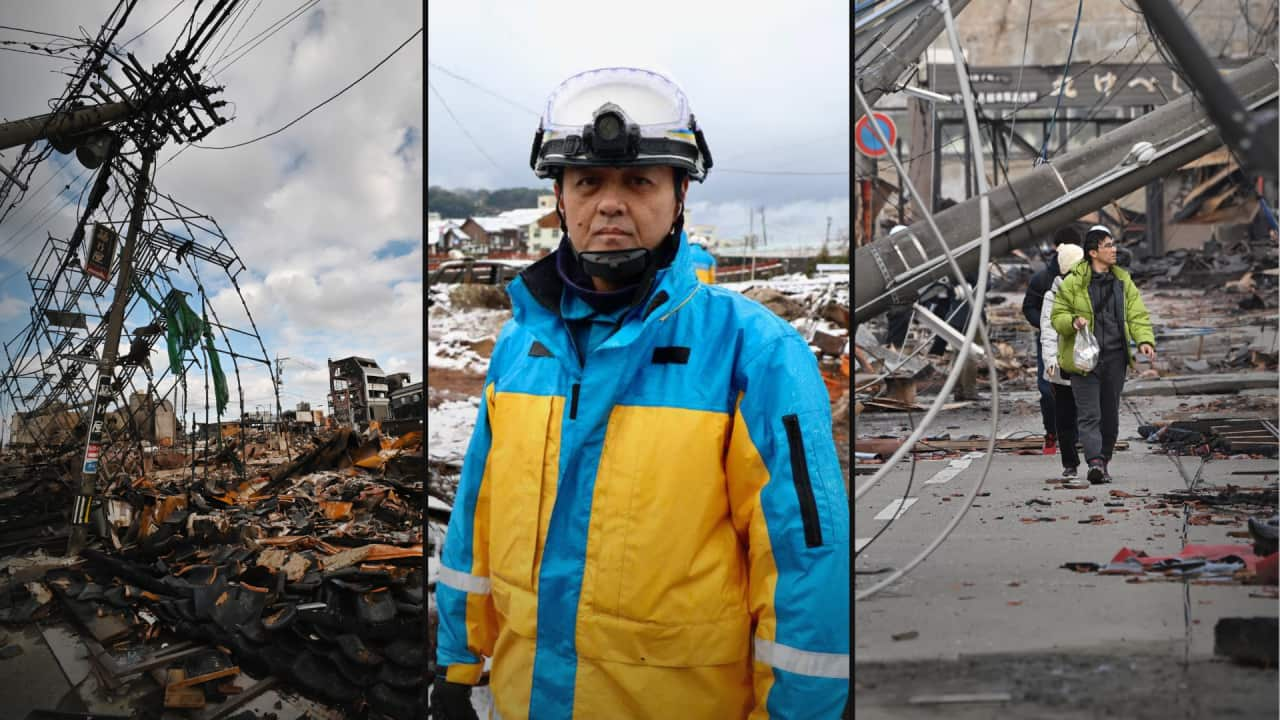A week after the earthquake that shook Japan on 1 January, dozens of police officers were on location at Wajima – one of the worst-hit places – working in two-hour shifts to recover the remains of four people who lived there.
Tadahiro Ebita is a 59-year-old officer from Miyagi Prefecture. He is the rescue team leader.
“According to information we [have] received, they were at the house when the earthquake hit. They have since been reported missing, so we’re here to find them,” he tells SBS News.
The recovery team battles fatigue and frostbite and finds human remains while SBS News was at the scene.

A destroyed heritage building in Wajima. Credit: SBS News/Aaron Fernandes
He was a police officer and rescue coordinator during Japan’s devastating 2011 earthquake and tsunami which killed at least 18,500 people and triggered the meltdown at the Fukushima nuclear power plant.
He says memories of the devastation still haunt him but keep him focused on the recovery effort.
Finding the remains of the victims here is very important. It’s necessary to provide closure to the families.Tadahiro Ebita
Magnitude of disaster
Digging through piles of rubble with handheld tools, police officers in the Japanese city of Wajima desperately search for victims of the deadly New Year’s Day earthquake.
The 7.6 magnitude quake levelled homes across the Noto Peninsula, but Wajima is ground zero of the disaster.
Down every street and alley of the traditional fishing town, homes lie crushed on the ground, windows blown out, or fallen on top of cars.
At one intersection, a five-storey building sits toppled on its side.
Another neighbourhood resembles a war zone, thanks to a major fire that tore through the areas after the earthquake.
Quake, fire and ice
Local officials do not know exactly what caused the fire that followed the quake but suspect falling powerlines and the wooden structures of traditional buildings may have been the deadly mix.
A week after the quake, the area was blanketed in snow, making the painstaking task of searching through the rubble even more difficult.
“Today, we are digging carefully through the rubble. But now the snow is falling so quickly that we have to work even faster,” Ebita says.
The snow makes it even more difficult to find what we’re looking for. It’s very cold, our fingers are paralysed.Tadahiro Ebita
The town looks and feels very much like the set of a movie.
It’s eerily silent, interrupted only by the sound of creaking buildings, whirring helicopters overhead and people trying to salvage their belongings.

Delivery driver Ryouzo Kitano has salvaged what he can from his parents' home. Credit: SBS/Aaron Fernandes
Securing family and belongings
SBS News met 27-year-old delivery driver Ryouzo Kitano as he was desperately trying to salvage his family’s belongings.
The house he was raised in stood damaged before his eyes.
The intense shaking during the earthquake turned the interiors upside down.
The wall clock had locked in the time when the earth shook — 4:10pm on 1 January.
Ryouzu and his parents were lucky to escape.
“My dad and mum survived because they were on the first floor. The three of us ran out into the street and waited in the middle of the road for the shaking to stop,” he recalls.
More than 1,000 aftershocks have been reported since New Year's Day and many residents across the Noto Peninsula live with the constant fear that damaged homes could collapse.
Ryouzo’s parents are too old to help with the clean-up of their house.
He works quickly on his own to salvage what he can, worried that aftershocks could still bring the house down.
My mum and dad are really shaken. They are very quiet and are staying at an evacuation shelter today.Ryouzo Kitano
Delayed aid
The extensive damage to roads and infrastructure has slowed down and limited the reach of aid deliveries.
Water supply to around 90,000 households in Ishikawa and its surrounding prefectures has been impacted.
Food and fuel supplies are now running low.

A five-storey building lies collapsed on its side in Wajima. Credit: SBS/Aaron Fernandes
A week on from the disaster, tens of thousands remain without water and electricity, sparking concerns of disease and exposure to the cold.
SBS News visited several evacuation centres in Wajima and Nanao cities, observing hundreds of people sleeping on the floor with no access to running water and only a limited number of portable toilets.
Hisaaki Nakano, 65, was amongst the nearly 200 people sleeping at an elementary school in Nanao.

Hisaaki Nanako spends days and nights in a rescue shelter. Credit: SBS/Aaron Fernandes
“It’s not very comfortable here, sleeping like this. But there are many earthquakes (aftershocks) and I’m fearful. Even though my house is new, this place is safest for me,” he says.
He is amongst nearly 30,000 evacuees who now face an uncertain future not knowing if and when they'll be able to return home.

